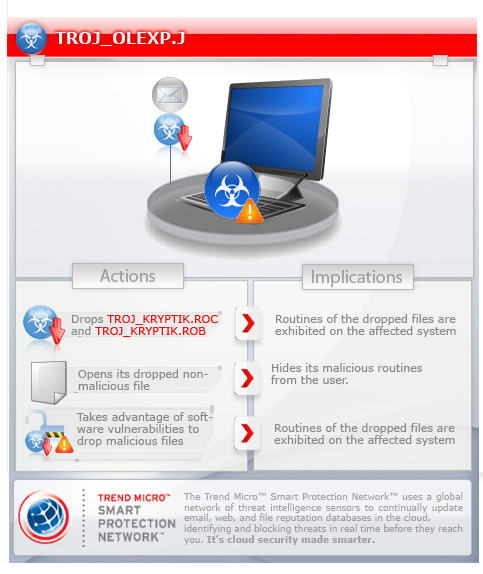TROJ_OLEXP.J
Exploit.CVE2012-0158.16 (DrWeb), Win32/Exploit.CVE-2012-0158.AJ (Eset), RTF:CVE-2012-0158-R (GData), Exploit.Win32.CVE-2012 (Ikarus), Exploit.Win32.CVE-2012-0158.j (Kaspersky),
Windows 2000, Windows Server 2003, Windows XP (32-bit, 64-bit), Windows Vista (32-bit, 64-bit), Windows 7 (32-bit, 64-bit)


Threat Type: Trojan
Destructiveness: No
Encrypted: Yes
In the wild: Yes
OVERVIEW
This malware was involved in the Red October campaign, a series of attacks targeting diplomatic and government agencies. It drops malicious files onto the affected system and executes them, causing certain malicious routines to be exhibited.
To get a one-glance comprehensive view of the behavior of this Trojan, refer to the Threat Diagram shown below.

This Trojan arrives as an attachment to email messages spammed by other malware/grayware or malicious users. It arrives on a system as a file dropped by other malware or as a file downloaded unknowingly by users when visiting malicious sites.
It executes the files it drops, prompting the affected system to exhibit the malicious routines they contain.
TECHNICAL DETAILS
Arrival Details
This Trojan arrives as an attachment to email messages spammed by other malware/grayware or malicious users.
It arrives on a system as a file dropped by other malware or as a file downloaded unknowingly by users when visiting malicious sites.
Installation
This Trojan drops the following non-malicious file:
- %Program Files%\Windows NT\wsdktr.ltp
- %User Temp%\{malware file name}.doc
(Note: %Program Files% is the default Program Files folder, usually C:\Program Files in Windows 2000, Server 2003, and XP (32-bit), Vista (32-bit), and 7 (32-bit), or C:\Program Files (x86) in Windows XP (64-bit), Vista (64-bit), and 7 (64-bit).. %User Temp% is the current user's Temp folder, which is usually C:\Documents and Settings\{user name}\Local Settings\Temp on Windows 2000, XP, and Server 2003, or C:\Users\{user name}\AppData\Local\Temp on Windows Vista and 7.)
Dropping Routine
This Trojan drops the following files:
- %Program Files%\Windows NT\svchost.exe - detected as TROJ_KRYPTIK.ROC
- %User Temp%\msmx21.exe - detected as TROJ_KRYPTIK.ROB
(Note: %Program Files% is the default Program Files folder, usually C:\Program Files in Windows 2000, Server 2003, and XP (32-bit), Vista (32-bit), and 7 (32-bit), or C:\Program Files (x86) in Windows XP (64-bit), Vista (64-bit), and 7 (64-bit).. %User Temp% is the current user's Temp folder, which is usually C:\Documents and Settings\{user name}\Local Settings\Temp on Windows 2000, XP, and Server 2003, or C:\Users\{user name}\AppData\Local\Temp on Windows Vista and 7.)
It takes advantage of the following software vulnerabilities to drop malicious files:
It executes the files it drops, prompting the affected system to exhibit the malicious routines they contain.
NOTES:
Upon execution, this Trojan opens its dropped non-malicious file %User Temp%\{malware file name}.doc in order to hide its malicious routines from the user.
SOLUTION
Step 1
Before doing any scans, Windows XP, Windows Vista, and Windows 7 users must disable System Restore to allow full scanning of their computers.
Step 2
Remove the malware/grayware file dropped/downloaded by TROJ_OLEXP.J
- TROJ_KRYPTIK.ROC
- TROJ_KRYPTIK.ROB
Step 3
Restart in Safe Mode
Step 4
Search and delete these files
- %Program Files%\Windows NT\wsdktr.ltp
- %User Temp%\{malware file name}.doc
Step 5
Restart in normal mode and scan your computer with your Trend Micro product for files detected as TROJ_OLEXP.J. If the detected files have already been cleaned, deleted, or quarantined by your Trend Micro product, no further step is required. You may opt to simply delete the quarantined files. Please check this Knowledge Base page for more information.
Step 6
Download and apply these security patches Refrain from using these products until the appropriate patches have been installed. Trend Micro advises users to download critical patches upon release by vendors.
Did this description help? Tell us how we did.


